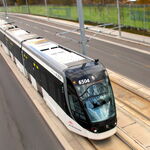micheal_can
Senior Member
Notice how other service has been built in Toronto since the Sheppard line has opened? That is the way to go.So much better to not have any service. "Perfect" should defeat good.
Notice how other service has been built in Toronto since the Sheppard line has opened? That is the way to go.So much better to not have any service. "Perfect" should defeat good.
We don't build transit because Toronto has made it catastrophically expensive. We are spending nearly $1b/km on subways. It is madness.Notice how other service has been built in Toronto since the Sheppard line has opened? That is the way to go.
Most of the stuff we are building since Sheppard are LRT lines lol. This isn't the point in favour of continuing existing subway lines underground that you seem to think it is. Look at the speed at which Finch is being built, or how fast we built the surface part of the Crosstown. Now look how long it takes to build something underground like the TYSSE, or the underground part of the Crosstown. Part of the reason the Ontario Line is able to get to Eglinton in the same timeframe as the RL only went to Pape is because much of the northern part is elevated. The bizarre obsession this city that transit only has value if we spend billions to hide it underground is silly and counterproductive to actually building transit.Notice how other service has been built in Toronto since the Sheppard line has opened? That is the way to go.
The long time frame is a problem when we are playing catch up. Ideally the projects should be staggered, so even if it takes 10 years for completion of one project, you'll get something done every few years going forth.Most of the stuff we are building since Sheppard are LRT lines lol. This isn't the point in favour of continuing existing subway lines underground that you seem to think it is. Look at the speed at which Finch is being built, or how fast we built the surface part of the Crosstown. Now look how long it takes to build something underground like the TYSSE, or the underground part of the Crosstown. Part of the reason the Ontario Line is able to get to Eglinton in the same timeframe as the RL only went to Pape is because much of the northern part is elevated. The bizarre obsession this city that transit only has value if we spend billions to hide it underground is silly and counterproductive to actually building transit.
I'm all for extending Sheppard as a subway to Sheppard west, but it would be better if we could elevate as much as possible. As for eastward, I think underground to Vic Park is the one place you can justify an extension underground, but anything beyond that it should be elevated or LRT. It just makes no sense to build less transit, much more slowly, when we have a crisis around a lack of rapid transit in this city.
Exactly. Even LRT in Toronto is costing more than actual metros in other places.We don't build transit because Toronto has made it catastrophically expensive. We are spending nearly $1b/km on subways. It is madness.
Most of the stuff we are building since Sheppard are LRT lines lol. This isn't the point in favour of continuing existing subway lines underground that you seem to think it is. Look at the speed at which Finch is being built, or how fast we built the surface part of the Crosstown. Now look how long it takes to build something underground like the TYSSE, or the underground part of the Crosstown. Part of the reason the Ontario Line is able to get to Eglinton in the same timeframe as the RL only went to Pape is because much of the northern part is elevated. The bizarre obsession this city that transit only has value if we spend billions to hide it underground is silly and counterproductive to actually building transit.
I'm all for extending Sheppard as a subway to Sheppard west, but it would be better if we could elevate as much as possible. As for eastward, I think underground to Vic Park is the one place you can justify an extension underground, but anything beyond that it should be elevated or LRT. It just makes no sense to build less transit, much more slowly, when we have a crisis around a lack of rapid transit in this city.
The actually cost is around $1.2b.No way FWLRT is $2.5bn. That must be the funny math where it includes 30yrs operating or something. Or have I missed something and it truly is 2.5bn lol? Things cost so much here I don't even know anymore
Don't be fooled by the P3 contract prices, actual construction cost is often a small fraction of the total contract cost depending on the project.Exactly. Even LRT in Toronto is costing more than actual metros in other places.
FWLRT is 11km and is costing $2.5B CAD, which is 227M CAD/km or 179M USD/km
REM is is 67km and is costing $6.3B CAD, which is 94M CAD/km or 74M USD/km
Vancouver's Evergreen extension and Canada line both cost around $100M USD/km
Stockholm's completely underground Barkarby metro extension is costing 115M USD/km.
Athens Line 4, also completely underground, is costing 134 M USD/km
Everything built in Spain has cost under $100M USD/km except for a handful of Barcelona projects at $160M USD/km
etc. etc.
Continental Europe mostly builds for about $100M-300M USD/km with Scandinavia and Southern Europe being cheaper.
Toronto's (actually, North America's) cost problem is frankly embarrassing and ridiculous. It seems the only North American organization capable of building reasonably priced transit lines these days is the CDPQ, even historically good Vancouver is now building the Broadway Subway for $400M USD/km and STM's Blue Line extension is now like 600M USD/km.
Whoops, my bad. I did think it was a bit high.Don't be fooled by the P3 contract prices, actual construction cost is often a small fraction of the total contract cost depending on the project.
For contracts where it includes years of operations and maintenance, I've heard it's often about half the total contract value. So for a $2.5 billion project, you are looking at $1.2 billion in construction.
Well, REM re-uses a significant portion of track from the Duex-Montagnes commuter line. It they had to dig it all new it would have been more.Whoops, my bad. I did think it was a bit high.
Even at $1.2B though, it's still at $85 USD/km, which is still more expensive than REM, and still more expensive than some Spanish, Nordic, Italian, and Turkish subways. This is a really underappreciated and extremely bad problem.
Yes, of course I know that. But I'm comparing it to Finch West, which is literally a streetcar.Well, REM re-uses a significant portion of track from the Duex-Montagnes commuter line. It they had to dig it all new it would have been more.
If REM numbers are lower, it doesn't include that new bridge over the St. Lawrence either. It's a completely separate deck for the two LRT tracks.Well, REM re-uses a significant portion of track from the Duex-Montagnes commuter line. It they had to dig it all new it would have been more
~35km of REM runs on an existing rail corridor which is being converted, which is already electrified and fully graded. Even if some small changes on the corridor are needed and stations need to be upgraded, it's insanely cheap because of it.
Another 5.5km run in a highway median, which requires a few new structures but no utility relocations or significant grading. Again, cheap.
Only the remaining 26km are really "expensive" new construction, and even then they are mostly still at grade or elevated corridors other than the tunnel into the airport.
In-median LRTs are quite expensive as not only do they have to build the LRT tracks, they have to build a new 4-lane road, utilities included. That adds a ton of cost. If you can just build the rail line, it's a lot cheaper.
Those new 4-lane roads would need reconstruction at some point regardless though, so it saves the municipality that cost.




